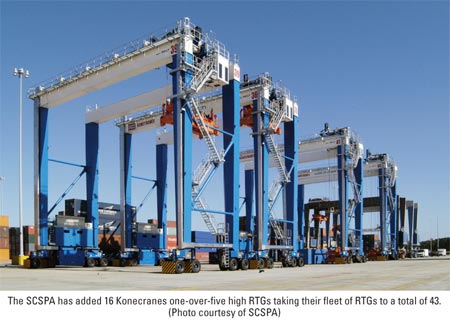 By Karen E. Thuermer, AJOT
By Karen E. Thuermer, AJOTThe figures are staggering. More than two billion tons of foreign and domestic commerce move through US ports each year. With increasing amounts of that cargo shipped as containerized freight, transporting containers in, around, and out of the port as quickly as possible is the central goal of each seaport. Steamship lines assess how fast and efficient a port can perform these tasks and it is a key consideration when they consider port rotations.
Last year, for example, the Port of Baltimore secured an impressive line up of new services that included the CMA-CGM and China Shipping Lines and first port of call for MSC’s North Atlantic service. A driving factor to attracting these services was not only Baltimore’s efficient port operations, but how equipment can move and arrange containers in order to increase container capacity. Thanks to the port’s utilization of 12 Rubber Tired Gantry (RTG) cranes at Seagirt Marine Terminal, its container capacity was increased 50%. Consequently, the terminal has room to accommodate these steamship lines’ growth.
This is a critical factor given that most US seaports have limited capacity to expand. In fact, it is expected that the existing terminal capacity at most US seaports will be exceeded by 2010. Currently, intensified competition with other seaports as well as other modes of transportation is forcing seaports to operate more efficiently than ever. Container handling is a critical component. Reducing the number of times a container is handled and moved (“dwell time”) requires faster processing of documents and the secure movement of cargo and vehicles.
SCSPA equipment investmentIn order to remain competitive, the South Carolina State Ports Authority (SCSPA) has invested heavily in new cranes and equipment in recent years. In September 2005, SCSPC, which oversees the Port of Charleston’s container terminal operations, approved the largest single equipment purchase in the agency’s 65-year history, authorizing just under $64 million in new and upgraded equipment.
“Larger ships and growing volume are driving the investments, which will be complete by mid-2007,” comments Byron D. Miller, SCSPA spokesman.
While post-Panamax ships are common sights on the US West Coast and in Europe and Asia, few offer regular rotations on the East Coast.
“However, Charleston regularly handles ships up to 6,700 teus,” Miller says.
An additional factor is the expected dedication of post-Panamax ships to trans-Suez services between Asia and the East Coast. Already cargo volume at Charleston has increased between 1996 and 2006 from just over one million teus to 1.96 million teus.
“The SCSPA has focused on improving efficiencies as opposed to only increasing the terminal footprint,” Miller adds. “Charleston has enhanced utilization and productivity through longer gate hours, denser stacking, new gate systems and other initiatives.”
In June 2007, the SCSPA’s port wide crane productivity was 40 moves per hour per crane and trucker turn times averaged 20.8 minutes.
More than half of the total investment approved for Charleston is for dockside handling equipment. This includes four new super post-Panamax cranes from ZPMC of Shanghai, China, at a cost of $33 million.
To further increase capacity and performance, SCSPA is investing in newer, better equipment and upgrading existing equipment. Yard equipment in the recent purchase includes 16 RTGs, taking the SCSPA’s fleet of RTGs to 43 machines. Also included are two full container handlers, two empty container handlers, kits to upgrade 13 existing full container handlers and two lift trucks for on-terminal chassis storage.
Yard modifications and beyondSeveral factors drove the need for the new RTGs. Prior to the purchase the SCSPA operated a fleet of 30 RTGs used for stacking containers at Charleston’s three container terminals. New contract


